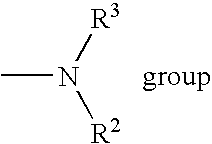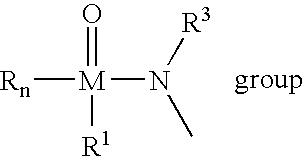In situ extraction of hydrocarbons from hydrocarbon-containing materials
a hydrocarbon and hydrocarbon-containing technology, applied in the field of in situ extraction of hydrocarbons from hydrocarbon-containing materials, can solve the problems of increasing demand and consumption for fossil fuels hereafter, liquefaction, solubilization and extraction technologies or processes that have not proven commercially viable on a large scale, and are extremely difficult to achiev
- Summary
- Abstract
- Description
- Claims
- Application Information
AI Technical Summary
Benefits of technology
Problems solved by technology
Method used
Image
Examples
example 1
[0062]In this example, coal from the Pittsburgh seam in Washington County, Pa. was liquefied with reagent α-terpineol. The coal sample was obtained from the Coal Bank at Pennsylvania State University, which provided the following proximate analyses for it; 2.00 wt. % of as-received moisture, 9.25 wt. % of dry ash, 38.63 wt. % of dry volatile matter, and 50.12 wt. % of dry fixed carbon. The particle size of coal sample was about 60 mesh. About 60 grams of reagent was gently added to about 30 grams of the coal sample placed in a Pyrex jar (reactor), thus giving rise to the reagent-to-sample ratio of 2 to 1. The capped, but not tightly sealed, Pyrex jar (reactor) containing the resultant mixture of α-terpineol and coal was maintained at the constant temperature of about 96° C. by immersing it in boiling water in a heated beaker and continually agitated by hand. Without boiling of reagent α-terpineol, the pressure in the Pyrex jar remained at the ambient pressure of slightly less than a...
example 2
[0063]This example is identical to Example 1 in all aspects except two: After maintaining the temperature at about 96° C., for about 30 minutes as done in Example 1, the Pyrex jar (reactor) containing the coal sample and reagent α-terpineol was placed in a beaker containing silica oil to maintain its temperature at about 135° C. for an additional period of about 30 minutes; the pressure in the Pyrex jar (reactor) remained at the ambient pressure of slightly less than about 1.01×105 Pascals (1 atm). The conversion, i.e., the degree of liquefaction, of the coal sample was determined to be about 70 wt. % instead of about 68 wt. % attained in Example 1.
example 3
[0064]The coal sample used was from the same source with the same proximate analyses as those used in the preceding two examples. About 31 grams of reagent α-terpineol were added to about 31 grams of the coal sample in a Pyrex jar (reactor,), thus giving rise to their ratio of 1 to 1. The experiment (operation) was carried out by maintaining the mixture in the Pyrex jar (reactor) at the temperature of about 96° C. and the ambient pressure of slightly less than about 1.01×105 Pascals (1 atm) for about 30 minutes. The conversion, i.e., the degree of liquefaction, of the coal sample attained was determined to be about 71 wt. % by weighing the sample after filtering, washing, and drying as done in the preceding two examples.
PUM
 Login to View More
Login to View More Abstract
Description
Claims
Application Information
 Login to View More
Login to View More - R&D
- Intellectual Property
- Life Sciences
- Materials
- Tech Scout
- Unparalleled Data Quality
- Higher Quality Content
- 60% Fewer Hallucinations
Browse by: Latest US Patents, China's latest patents, Technical Efficacy Thesaurus, Application Domain, Technology Topic, Popular Technical Reports.
© 2025 PatSnap. All rights reserved.Legal|Privacy policy|Modern Slavery Act Transparency Statement|Sitemap|About US| Contact US: help@patsnap.com



